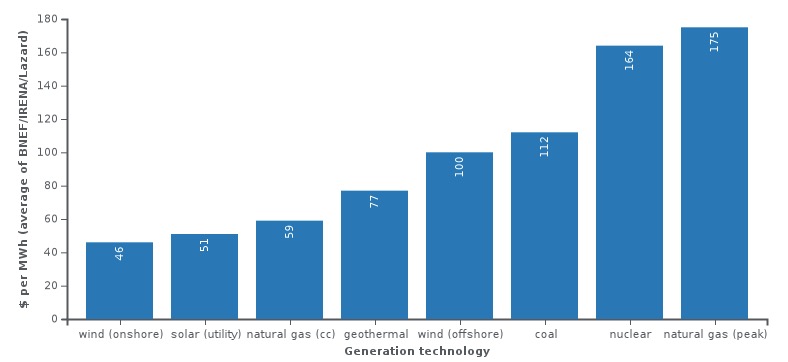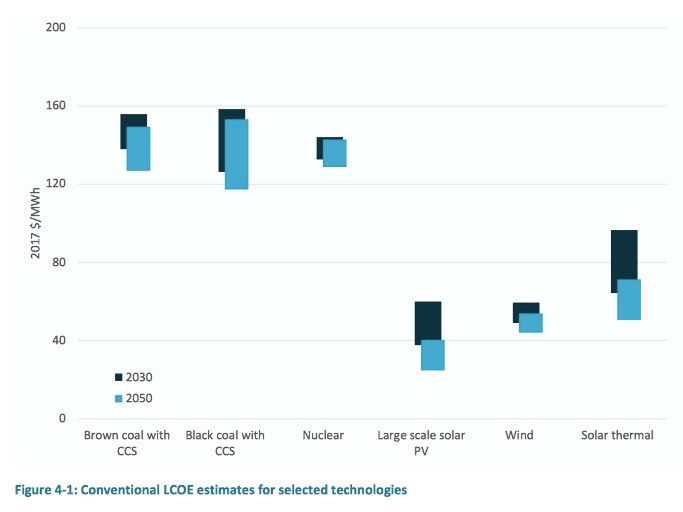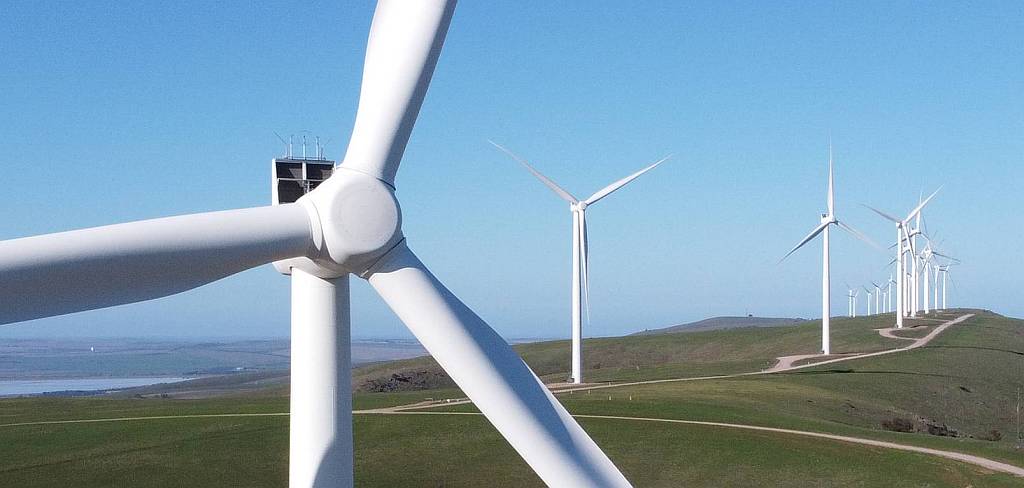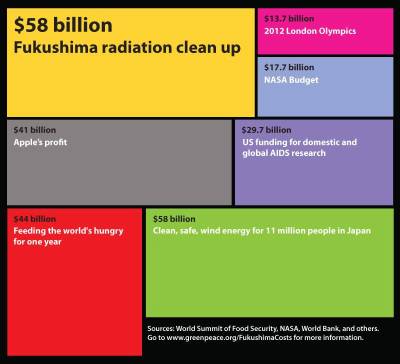| |
Nyngan solar PV farm, NSW; 102 MW
|
|---|
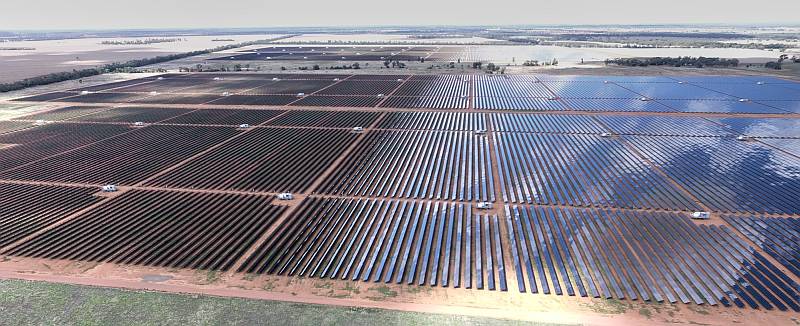
| Solar PV at this sort of scale is far less expensive than nuclear power.
Pumped hydro power or possibly batteries (expensive in 2017) can be used to store the power for use when the light is not bright.
| |
If nuclear power is ever to become a credible and viable source of
electricity it should be able to pass a number of tests.
- It must be possible to convincingly demonstrate that when its total
emissions – from mine to dump and decommissioning – are taken
into account it is a genuinely low-carbon option.
- We must be able to know exactly where and how the waste is disposed of.
- The whole nuclear cycle, mining, planning, building, running, decommissioning, disposal of waste and insurance must be economically viable and not require government subsidy.
(Enough subsidy to allow the power produced to compete with fossil fuel electricity could be excepted, see Level playing field.)
- There must be convincing evidence that no civil nuclear materials will be
diverted for military purposes or used for terrorism.
- The uranium must be used efficiently (that is, a large percentage of the
potential energy is utilised – not the approximately 1% that is
currently extracted – before the 'spent' fuel is dumped.)
- The risks posed by the huge radiation leakage that would result from the bombing of nuclear power stations in war time must be fully taken into account.
- Finally, one condition that before the Fukushima fiasco might have been thought obvious; no plants should be built on major fault zones, on tsunami-prone coasts, on eroding seashores or those likely to be inundated before the
plant has been decommissioned or any other places which are geologically unsafe.
(Some of the points above were adapted from an article by George Monbiot.)
|
|
| Wind power overtakes nuclear in China
|
|---|
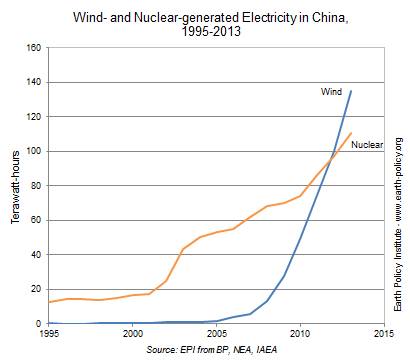
| | Graph credit Earth Policy Institute
| |
A piece by J. Matthew Roney of the
Earth Policy Institute was published on 2014/03/04:
"In China, wind power is leaving nuclear behind.
Electricity output from China's wind farms exceeded that from its nuclear
plants for the first time in 2012, by a narrow margin.
Then in 2013, wind pulled away-outdoing nuclear by 22 percent.
The 135 terawatt-hours of Chinese wind-generated electricity in 2013 would be
nearly enough to power New York State."
This seems to be a demonstration that nuclear power is simply not an
economically viable option any more, irrespective of its environmental
questions and advantages or disadvantages.
| |
This section added
2017/01/24
Edited 2021/06/11
|
|
Not many nuclear power stations have been fully decommissioned, certainly it is difficult to obtain reliable figures on decommissioning costs.
In a
report to the UK Parliament titled "The Nuclear Decommissioning Authority’s management of the Magnox contract" it was stated that:
"The cost of the long-term liability to decommission the UK’s civil nuclear sites now stands at £132 billion..."
That's worth emphasising,
£132 billion (Aus$236b, US$183b). It's an eye-watering amount, and it is only for decommissioning. And we all know that costs tend to increase as the job gets done.
The US Energy Information Administration produced a
report on decommissioning titled 'Decommissioning nuclear reactors is a long-term and costly process' in November 2017. Quoting from that document:
"One of the most recently decommissioned reactors in the United States is the 619 megawatt (MW) Haddam Neck plant in central Connecticut, which was shut down in 1997 and decommissioned using the DECON method. Haddam Neck’s decommissioning was completed in 2007 at a total cost of $893 million."
Wikipedia, 2017/01/24, listed estimated decommissioning costs varying
from US$153 million to US$514 million per reactor.
In the USA 'in-situ decommissioning', that is the entombment of nuclear
power stations cost US$73 million for two reactors.
Whether leaving the reactors in place indefinitely can truly be called
'decommissioning' is highly questionable.
Wikipedia stated that:
"In 2016 the European Commission assessed that European Union's nuclear
decommissioning liabilities were seriously underfunded by about 118 billion
euros, with only 150 billion euros of earmarked assets to cover 268 billion
euros of expected decommissioning costs covering both dismantling of nuclear
plants and storage of radioactive parts and waste."
The cleaning up of mines at the ends of their useful lives has historically
been seriously underfunded; often leaving a large part of the costs to be
covered by tax-payers.
Can we have any confidence that the decommissioning of nuclear power stations
will be properly funded?
If the world was to change from using just the 0.7%
235U in
uranium to using 100% of it (including the 'harder to burn'
238U)
there would be so
much nuclear fuel available around the world, from old nuclear fuels,
depleted uranium stock-piles, etc., that there would probably be no need
to mine uranium for a hundred years.
This would not be good for the big uranium mining companies; they would
resist such a move as strongly as they possibly could, and companies like
BHP have a lot of push with governments.
| |
|
This section written 2011/03/31
|
|
| |
Fukushima nuclear power station, Google Earth image, copied 2021/04/13
|
|---|

| The great many round objects are tanks, apparently all, or most, are full of intercepted contaminated water. It was announced in April 2021 that some of the water would be 'treated' and released into the ocean; a controversial proposal.
Click on the image to see it in higher definition.
| |
It seems, to an outsider, that the problems that were triggered by the
earthquake of 11th March 2011 showed a degree of incompetence in the
siting, design and subsequent operation of the plant.
Blindingly obvious in hind-sight, the power station was sited too close
to the sea.
Apparently the tsunami was a metre or so higher than the largest that was
planned for!
Why not allow a ten or twenty metre safety margin rather than a metre or so?
There seems to have been little planning for backup cooling in emergencies.
How difficult can it be to plan for several alternative ways of getting a
flow of cooling water into a power station?
No doubt it's easy to criticise from a distance.
What will it mean to the future of nuclear power?
As I write this (2011/03/31) it seems very likely that the meltdown and
nuclear contamination at Fukushima will strengthen the anti-nuclear
lobby and make nuclear power more unpopular world-wide.
The alternatives are:
- Coal
- To burn more coal will exacerbate the already dire
climate change problem.
It would fix the short term problem at the expense of increasing the long
term one.
- Petroleum (oil and gas)
- This is the quick, easy option.
Unfortunately it has the same problem as coal; increasing greenhouse gas emissions.
- Sustainable energy
- Sustainable energy is a viable
alternative.
- Energy conservation
- There are huge potentials for reducing our profligate rate of energy
consumption.
Energy conservation combined with increased development of sustainable
energy is the only responsible option that is viable in the
long term (sustainable energy always was the only energy option really,
the alternative, unsustainable energy, is by definition not sustainable).
Wind energy is a mature technology and can be developed much further than
where it stands in 2011, but it will never be "the answer" to the energy
problem on its own.
Solar can and should be developed much further; it is not yet
the mature technology that wind power is, but perhaps that should be thought
of as an oportunity rather than a problem.
| |
This section written
2017/09/01
|
|
Joe Romm wrote for
RenewEconomy on 2017/09/01 about Duke Energy in Florida announcing that
it would terminate all plans to build its Levy Nuclear Project and instead
invest $6 billion in solar energy, smart meters, and grid modernization as
well as electric vehicle (EV) charging stations and a battery storage pilot
program.
Here is yet another reason to not build nuclear power stations: quoting from
an article in RenewEconomy –
The so-called "nuclear renaissance" in the United States has had another
major setback, with another two nuclear reactors under construction in South
Carolina abandoned after costs spiralled out of control, leaving consumers
holding the bill for plants that will never be completed.
Procon,
2017/08/04, reported:
"On Monday July 31, the South Carolina Electric and Gas Company announced
that it was abandoning construction on two new nuclear power reactors at the
V.C. Summer Nuclear Station in Jenkinsville, SC due to cost overruns and
delays in construction.
The two nuclear reactors were 40% complete, and $9 billion dollars had
already been spent on their construction.
The two reactors were originally scheduled to come online in 2018, however,
due to regulatory disputes and construction problems, the utility announced
early in 2017 that the reactors would not begin producing electricity before
2021.
The utility also announced that completing construction could cost up to $25
billion, over twice the original estimate of $11.5 billion."
| |
This section added
2018/04/08
Edited 2021/06/12
|
|
There are some advantages (and disadvantages) in using thorium to fuel a nuclear power station rather than uranium.
Whether these will prove sufficient to make thorium a viable source of non-polluting power remains to be seen.
Thorium is more plentiful in the earth's crust than is uranium, but the naturally occurring thorium isotope is not fissile so it must be placed in a uranium powered reactor to change the non-fissile isotope to a fissile isotope before it can produce electricity.
Thorium fuelled nuclear power stations would suffer from a number of the problems of uranium fuelled stations: embrittlement, no recycling of materials, very high cost of decommissioning, etc.
A research paper written by Greg Baker for the Australian parliament in 2007-8 contained the following in its Executive Summary:
- "Thorium is a radioactive element that can be used in a new generation of nuclear reactors as an alternative source of fuel for the generation of electricity.
- A thorium-based fuel cycle is more proliferation resistant than conventional uranium-based reactors though there is still a degree of risk.
- A thorium-based fuel cycle is less accident prone and is more energy efficient than conventional uranium-based reactors.
- Thorium-based fuel cycle waste products are not as long lived as those from conventional nuclear reactors.
- Thorium is abundant in Australia.
- There are technical issues still needing resolution before a thorium-based fuel cycle can become common.
- Even if the technical issues can be resolved there are still residual environmental concerns in the mining, handling and storage of radioactive materials."
I gather that at the time of writing (June 2021) there are no power stations using thorium as the main fuel anywhere in the world. Quoting from Wikipedia:
"Between 1999 and 2021, the number of operational thorium reactors in the world has risen from zero, to a handful of research reactors, to commercial plans for producing full-scale thorium-based reactors for use as power plants on a national scale."
Thorium cannot at present be considered as a serious contender for producing a substantial part of the world's power demands.
| |
This section added
2021/09/30
|
|
Nuclear failures are numerous and hugely expensive
Apart from spectacular disasters like Chernobyl and Fukushima there are many examples of economic failures in the development, construction and running of nuclear power stations, especially in recent years.
The world's nations and electricity generation industries have been forced to recognise that, like the coal industry, there is no future for nuclear power.
|
World growth in nuclear power has stalled
In an
article for the PV Magazine written by Emiliano Bellini, and published 2021/09/28 it was pointed out that the "world’s operational nuclear capacity grew by just 400 MW [0.4 GW] in 2020, with generation falling by 4%." Bellini went on "By contrast, renewables grew by 256 GW and clean energy production rose by 13%."
(That situation has not improved at all for nuclear by 2023.)
Bellini was referring to the World Nuclear Industry Status Report, published by French nuclear consultant Mycle Schneider. Bellini wrote "According to the report, the levelized cost of energy (LCOE) of solar PV dropped by approximately 90% over the past few years, while the LCOE of nuclear energy climbed by around 33%."
The Record-Breaking Failures of Nuclear Power
An
article for Counter Punch written by Linda Gunter and published 2021/09/24 was headlined The Record-Breaking Failures of Nuclear Power. Gunter started by writing that the Tennessee Valley Authority had taken 42 years to build and bring on line Watts Bar Unit 2 nuclear power reactor in Tennessee. She went on: "Watts Bar 2 achieved criticality in May 2016, then promptly came off line due to a transformer fire three months later."
Gunter also wrote that "Now, almost five years later [than the Watts Bar story], TVA has announced it has abandoned its unfinished two-reactor Bellefonte nuclear plant in Alabama, a breathtaking 47 years after construction began."
The article went on:
"... of the 30 reactors the [US nuclear] industry planned to build 15 years ago with the so-called nuclear renaissance, only two are still being built. (Those two, at Plant Vogtle in Georgia, are years behind schedule with a budget that has more than doubled to $27 billion.)"
Wikipedia has an article on the Bellefonte nuclear plant.
And then, of course, there were the two part built nuclear power stations abandoned in South Carolina back in 2017, detailed in another section on this page.
| |
This section added
2020/02/01
|
|
Extracted from
Wikipedia: Nuclear power phase-out;
"Following the March 2011 Fukushima nuclear disaster, Germany has permanently shut down eight of its 17 reactors and pledged to close the rest by the end of 2022. Italy voted overwhelmingly to keep their country non-nuclear. Switzerland and Spain have banned the construction of new reactors.
As of 2016, countries including Australia, Austria, Denmark, Greece, Ireland, Italy, Latvia, Liechtenstein, Luxembourg, Malaysia, Malta, New Zealand, Norway, Philippines, and Portugal have no nuclear power stations and remain opposed to nuclear power. Belgium, Germany, Spain and Switzerland are phasing-out nuclear power."
| |
This section added
2019/06/25
|
|
In 2019 there was no nuclear electricity generation in Australia but there was a push from some people for the development of nuclear power.
Those who are advocating nuclear power are often the same people who are opposing the further development of renewable power.
My impression is that these people know that we have to reduce greenhouse emissions, but they have some sort of ideological disliking for renewable energy (for whatever reason), so they see nuclear as a way out of what would otherwise be a dilemma for them.
The fact is that Australia's energy future is in renewables, as has been amply shown by South Australia's great success in adopting renewables.
Those in the pro-nuclear lobby, not surprisingly, either are ignorant of, or not willing to address the questions of:
- the high cost of nuclear,
- the very long lead time required to build nuclear power stations,
- the strong opposition that would inevitably come from the people living in the vicinity of any proposed nuclear power station,
- and all the other disadvantages of nuclear power.
Regarding the strong opposition to nuclear power, a major nuclear power station would have to be built on the coast of Australia because of the need of large volumes of cooling water and a generally very limited supply of fresh water in Australia.
It would also need to be built close to existing high-capacity power lines, which would rule out it being built in a remote area.
Places on the Australian coast near high-capacity power lines are generally highly populated.
As if to demonstrate this fact, in January 2022 there was a proposal for the building of a number of small modular nuclear power stations in Australia, one of which would be near my home and all of which would be in highly populated areas.
I have discussed below why nuclear power is not needed in Australia, one of the main reasons being that we have huge and largely untapped renewable energy resources.
It is also not wanted in Australia.
Nuclear power (as in the
proposal mentioned above, or anywhere else) is not needed in Australia, it is unpopular, it is expensive and it is slow to build. Nuclear power stations are inflexible in the amount of power that they generate; as we move toward 100% renewable energy what we need to supplement that is power on demand - such as from batteries or pumped hydro energy storage.
| |
SA generation record, 2007 to 2022
|
|---|

| Graphic extracted from Open NEM
| |
The graph on the right shows why nuclear power is not needed in Australia.
South Australia has gone from near zero renewable energy in 2003 to 62% in 2021; and the graph suggests that 100% renewable energy could be possible by 2027.
In the graph the green is wind power and the yellow above the green is solar power; both, of course, renewable. The shades of orange are gas-fired power, the brown is coal-fired, and the purple on the bottom is imported power from the eastern states. SA's last coal-fired power station shut down in May 2016.
What SA has done, the other Australian states could also do. Western Australia has been slow to take up renewable energy but it seems that is changing. For example, news of a proposed 500 MW wind farm of the coast of Perth was published in WA Today on 2022/01/10 (the day before I wrote this section). Even the WA Liberals aim to close all coal-fired power stations by 2025
| |
This section added
2023/07/28
|
|
A
Lowy Institute poll was conducted in 2011. It showed that when asked "Are you personally in favour or against Australia building nuclear power plants as part of its plans to cut greenhouse gas emissions? Is that strongly or somewhat?" 46% said they were strongly against and another 16% were somewhat against (a total of 62% against). 22% were somewhat in favour, only 13% were strongly in favour.
As an explanation of exactly what small modular nuclear reactors are, I suggest
Wikipedia. As of 2023 it seems that there are only three operating SMRs in the world, two in Russia and one in China. So it is far too early for anyone to provide an accurate estimate of what the cost of electricity might be from SMRs in the medium to long term.
It seems that the pro-nuclear power lobby has latched onto SMRs since conventional full-size nuclear power stations have been shown to be economically uncompetitive with wind and solar PV power generation.
Small Modular Nuclear Reactors Are Mostly Bad Policy; an article written for CleanTechnica by Michael Barnard, 2021/05/03.
Quoting from the CleanTechnica article:
| |
Proposal
A number of small modular nuclear reactors have been proposed in Australia as discussed elsewhere on this page. It was no more than a dream of supporters of nuclear power.
|
|
"Small modular reactors won’t achieve economies of manufacturing scale, won’t be faster to construct, forego efficiency of vertical scaling, won’t be cheaper, aren’t suitable for remote or brownfield coal sites, still face very large security costs, will still be costly and slow to decommission, and still require liability insurance caps. They don’t solve any of the problems that they purport to while intentionally choosing to be less efficient than they could be. They’ve existed since the 1950s and they aren’t any better now than they were then."
Small modular reactors have been proposed for electricity generation for several years now, but very few have actually been built.
| |
This section added
2023/07/27
|
|
Ex Australian independent Senator Rex Patrick wrote an article titled
Dutton’s Nuclear Folly: Small Modular Reactors a political mirage for Michael West Media on 2023/07/23. As Mr Patrick pointed out, small modular nuclear reactors are no more than a dream in 2023.
Quoting Mr Patrick:
"Russia has packaged two low powered nuclear ice breaker reactors in a floating barge to claim a first SMR. China has a demonstration SMR in Shidaowan. Apart from that, they don’t exist."
Mr Patrick gave figures from a study by the CSIRO indicating that power from solar and on-shore wind farms would cost about $50/MWh while electricity from small modular nuclear reactors would cost between $150 and $300/MWh in 2030.
Also see similar costings in Cost of Electricity in my page on electricity prices.
At the time of writing Peter Dutton was the leader of the Liberal Party opposition in Australia. As I've written elsewhere the federal Liberal Party has a policy of opposing renewable energy. This seems to be at the level of an obsession or a crusade and is deeply ingrained into the character of many in the federal parliamentary liberal party. Perhaps they receive their deluded beliefs from the right wing shock jocks such as Andrew Bolt and Alan Jones?
| |
This section added
2022/01/11
|
|
| |
Site of proposed nuclear power station, Mandurah, Western Australia
|
|---|
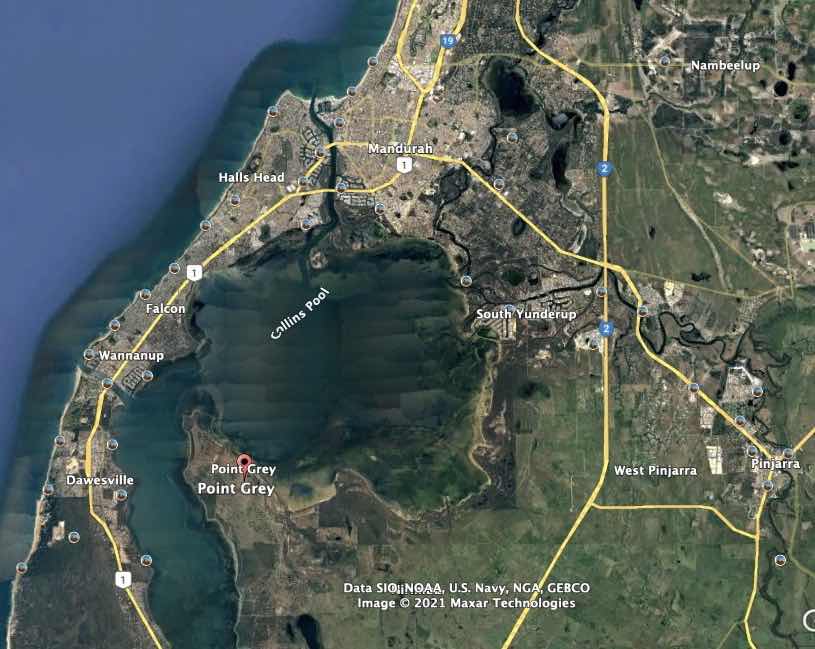
| The nuclear power station proposed site is at Point Grey, in the lower left of the image.
Image from Google Earth
| |
In what is no more than a pipe dream an organisation called Nuclear for Climate has
proposed a number of
small modular nuclear power stations for Western Australia. There are eleven in the proposal, six classed as 'probables' and five more as 'possibles', and all are in the highly populated south-western part of the state.
One of these would be on Point Grey about seven kilometres from my home in Erskine, a Mandurah suburb. (I suspect that the Nuclear for Climate group are unaware that the average depth of the lagoons that would supply the cooling water is only about 2 metres. Quite unsuitable for the purpose. There would be serious environmental problems with dumping the required amount of waste heat into them.)
Others in the 'probables' group are proposed for Tamala Park, a northern Perth suburb, Kwinana, Harvey and apparently a couple near Collie.
Something that has intrigued me for several years is that no one in the pro-nuclear camp is willing to discuss what would result if nuclear power stations were targeted in time of war. A bombed out nuclear power station would result in a radius of quite a few kilometres being uninhabitable. Conventional bombs would do the job, nuclear bombs would not be needed. The amount of nuclear material in a bomb is measured in kilograms, that in a nuclear power station is measured in tonnes.
| |
This section added
2022/02/16
|
|
At the time of writing
Hinkley Point C nuclear power station was under construction in the UK.
The following information was extracted from the Wikipedia article linked to above.
It was one of eight announced by the British government in 2010. As of October 2020, Hinkley is the only one of the eight designated sites to have commenced construction.
Early construction work stated 2008. According to the Wikipedia article completion was expected in 2026.
Cost expected was £22-23 billion.
Nameplate capacity 3260MWe.
Cost to consumers was expected to be £92.5 per megawatt-hour.
(The above prices were apparently in 2012 pounds. £92.5=Aud$172. One pound = Aud$1.86. They apparently don't include the enormous costs of eventual decommissioning. From reading
elsewhere on the Internet it seems that the £92.5 amount is the wholesale electricity price.)
Hinkley Point C power station is taking 18 years to build; a wind farm can be built in 18 months. Power from Hinkley will cost Aud$172/MWh, the wholesale cost of South Australian wind power in 2021 was $43/MWh. (According to the AEMO 2023 report average spot prices for electricity in SA were $33/MWh.)
Also see the nuclear power station construction projects abandoned due to cost overruns.
| |
This section added
2018/10/19
Edited 2024/03/31
|
|
External references
International
New Nuclear Power Plants Are Unlikely to Stop the Climate Crisis; Scientific American, by Naomi Oreskes, February 2022 Issue.
Naomi Oreskes is Henry Charles Lea Professor of the History of Science and Affiliated Professor of Earth and Planetary Sciences at Harvard University.
Quoting from Ms Oreskes' article:
"These plants take too long to build and bring online, and we don’t have that much time"
"What is it about nuclear energy that makes its advocates so determined in the face of what should be discouraging facts? After all, unlike futuristic, untried technologies, we have plenty of facts about this one, and most of them are discouraging."
Ms Oreskes goes on to note that nuclear power is the most expensive form of electrical generation in the USA, more than twice the cost of fossil fuel generation. And as I have noted elsewhere,
renewable electricty in the forms of wind and solar PV are cheaper than fossil fuel electricity, and getting cheaper all the time.
High-Priced and Dangerous: Nuclear Power Is Not an Option for the Climate-Friendly Energy Mix, DIW (German Institute for Economic Research) weekly report number 30, 2019.
Part built power stations abandoned August 2017:
an article in RenewEconomy –
The so-called "nuclear renaissance" in the United States has had another
major setback, with another two nuclear reactors under construction in South
Carolina abandoned after costs spiralled out of control, leaving consumers
holding the bill for plants that will never be completed.
More on this development
above on this page.
Failed nuclear power station converted to amusement park.
"This failed $5.3 billion nuclear power plant in Germany is now an amusement park that gets hundreds of thousands of visitors each year."
"The SNR-300 was supposed to be Germany's first fast breeder nuclear reactor when construction began in 1972. The reactor was made to use plutonium as fuel, and it would output 327 megawatts of energy.
Built in Kalkar, the government had some concerns about the safety of the nuclear reactor, which delayed construction. The power plant was finished in 1985 — $5.3 billion later.
But after the Chernobyl disaster in 1986, the SNR-300 never got a chance to fully operate, and by 1991 the project was officially canceled."
External references
Australian
CSIRO, 2023/12/20; The question of nuclear in Australia’s energy sector: In Australia's transition to net zero emissions, the energy sector has a major role to play. But does nuclear power have a place in our future grid?
Key Points:
. Nuclear power does not currently provide an economically competitive solution in Australia.
. Lead author of GenCost, Paul Graham, says updated costs for a key project in the US have been found to be very high.
. The costs for small modular reactors (SMRs) could improve over time, but will be too late to make a significant contribution to achieving net zero emissions.
Climate Council, 2024/03/15; Nuclear power stations are not appropriate for Australia - and never will be.
Is nuclear the answer to Australia’s climate crisis?
The Conversation, written by Reuben Finighan, PhD candidate at the London School of Economics and Research Fellow at the Superpower Institute, The University of Melbourne.
A quote from the Conversation article:
There are four arguments against investment in nuclear power: Olkiluoto 3, Flamanville 3, Hinkley Point C, and Vogtle. These are the four major latest-generation plants completed or near completion in Finland, the United States, the United Kingdom and France respectively.
Cost overruns at these recent plants average over 300%, with more increases to come. The cost of Vogtle, for example, soared from US$14 billion to $34 billion (A$22-53 billion), Flamanville from €3.3 billion to €19 billion (A$5-31 billion), and Hinkley Point C from £16 billion to as much as £70 billion (A$30-132 billion), including subsidies. Completion of Vogtle has been delayed by seven years, Olkiluoto by 14 years, and Flamanville by at least 12 years.
Mr Finighan went on to give the current cost of nuclear power to be between Aus$220 and $350 per Megawatt hour (MWh) while the cost of wind and solar power to be between $35 and $45/MWh. Firming (that is, using energy storage to make the power available at any time) would add another $25 to $34/MWh. "In short, a reliable megawatt hour from renewables costs around a fifth of one from a nuclear plant."
Dr Jim Green's research
Nuclear Power’s Economic Crisis and its Implications for Australia, published in December 2021 for Friends of the Earth (FoE) Australia.
In 2022, nuclear power’s future looks grimmer than ever, a summary of the FoE paper published by RenewEconomy, 2022/01/11, also by Dr Green.
"Nuclear power generation declined in 2021 and the industry’s future is grimmer than it has ever been."
"The marginal decline [in nuclear power] makes for a striking contrast with renewables. The International Energy Agency calculates that new renewable capacity added in 2021 amounted to nearly 290 GW – that’s more than four times Australia’s total electricity generating capacity."
Dr Green writes a long list of nuclear financial disasters and failed plans.
|
Is nuclear power globally scalable? By Derek Abbot, Fellow IEEE, School of Electrical and Electronics Engineering, University of Adelaide, Adelaide, S.A. 5005, Australia.
The short answer to the question is 'No'.
